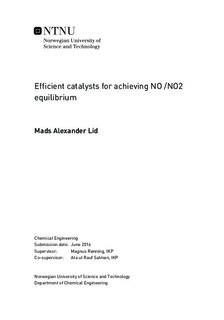Efficient catalysts for achieving NO /NO2 equilibrium
Master thesis
Permanent lenke
http://hdl.handle.net/11250/2416087Utgivelsesdato
2016Metadata
Vis full innførselSamlinger
Sammendrag
The aim of this work was to characterize an alumina supported Pt catalyst before and after post- and pre-modification with WO3. A 2wt%Ru/Al2O3 and a WO3/ZrO2 catalyst were also characterized. Pt/Al2O3 with a loading of 1wt%Pt was prepared by one step aqueous incipient wetness impregnation. Post and pre-modified 1wt%Pt-1.3wt%WO3 catalyst was prepared by two step aqueous incipient wetness impregnation. In this work, characterization by N2 adsorption, H2 and CO chemisorption, X-ray fluorescence (XRD), Scanning electron microscopy (SEM), energy-dispersive X-ray analysis (EDS), X-ray diffraction (XRD), temperature programmed reduction (TPR), Fourier transform infra-red Attenuated Total Reflectance (FTIR-ATR) and in-situ Diffuse Reflectance Infrared Fourier Transform Spectroscopy (DRIFTS) with pyridine adsorption were performed.Nitrogen adsorption showed that the addition of platinum and tungsten oxide did not alter the surface area, pore size or pore volume of the support. Chemisorption showed a good dispersion of platina on alumina, but this decreased slightly when modified by WO3, indicating blockage of active sites. XRF measurements shows a metal loading of 1.2wt\%Pt for unmodified catalyst, and 0.8wt%Pt and 0.7%wtWO3 for both post- and pre-modified catalyst. No reliable results were obtained from TPR, which could mean that platinum was already in its elemental state. Due to the low Pt and WO3 content and highly amorphous alumina, assignment of phase type or calculation of crystallite size with XRD was not feasible. Ex-situ investigation with ATR did not detect changes in the surface structure after addition of Pt and WO3.DRIFT investigations shows that band associated with strong and medium Lewis acid sites are barely present in Pt/Al2O3 catalyst. By contrast, these bands increased in intensity for post- and pre-modified catalyst. This indicates increased acidity of the alumina after WO3 addition.These results will later be used in the investigation of a suitable catalyst for the current non-catalytic NO oxidation step in nitric acid production.
